Making Sense of Organisations: Leadership Analysis
VerifiedAdded on 2020/01/23
|12
|3558
|111
Report
AI Summary
This report provides a comprehensive analysis of organizations, exploring their structure, management, and evolution. It begins with an introduction to organizations as social units with collective goals, emphasizing the role of management and employee contributions. The report then examines the significant changes that have occurred since the 20th century, including shifts from production-based to customer-based strategies, technological advancements, and the changing focus from machines to human resources. It delves into various leadership theories, such as the Great Man Theory, Trait Theory, and Behavioral Theories, highlighting their implications and relevance. The report also addresses the sociological factors that managers must consider in a globalized environment, such as varying customer needs and the shift towards democratic decision-making. It concludes by underscoring the importance of adapting to changing times and implementing the latest technologies to maintain a competitive edge, referencing key management principles and theories to support its arguments.
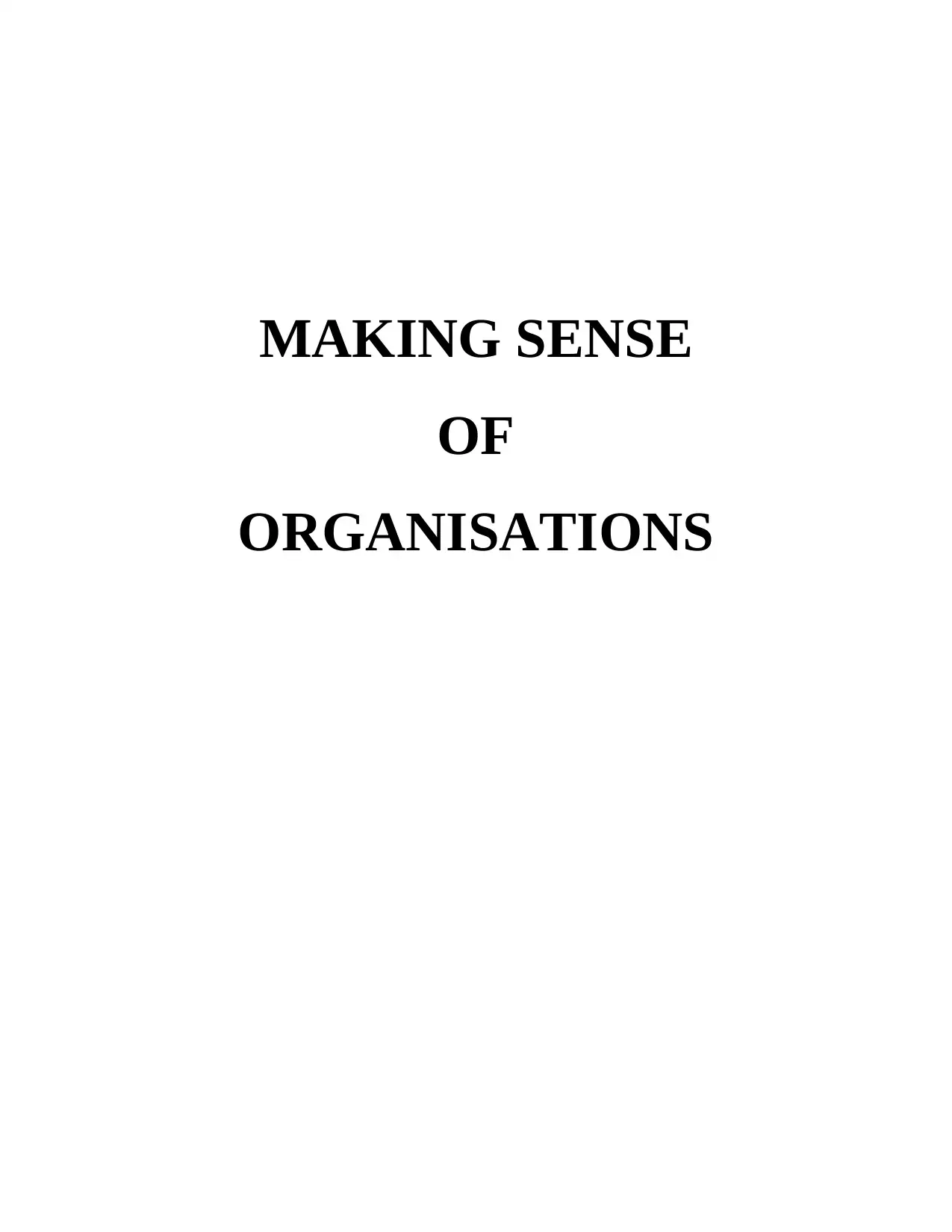
MAKING SENSE
OF
ORGANISATIONS
OF
ORGANISATIONS
Paraphrase This Document
Need a fresh take? Get an instant paraphrase of this document with our AI Paraphraser
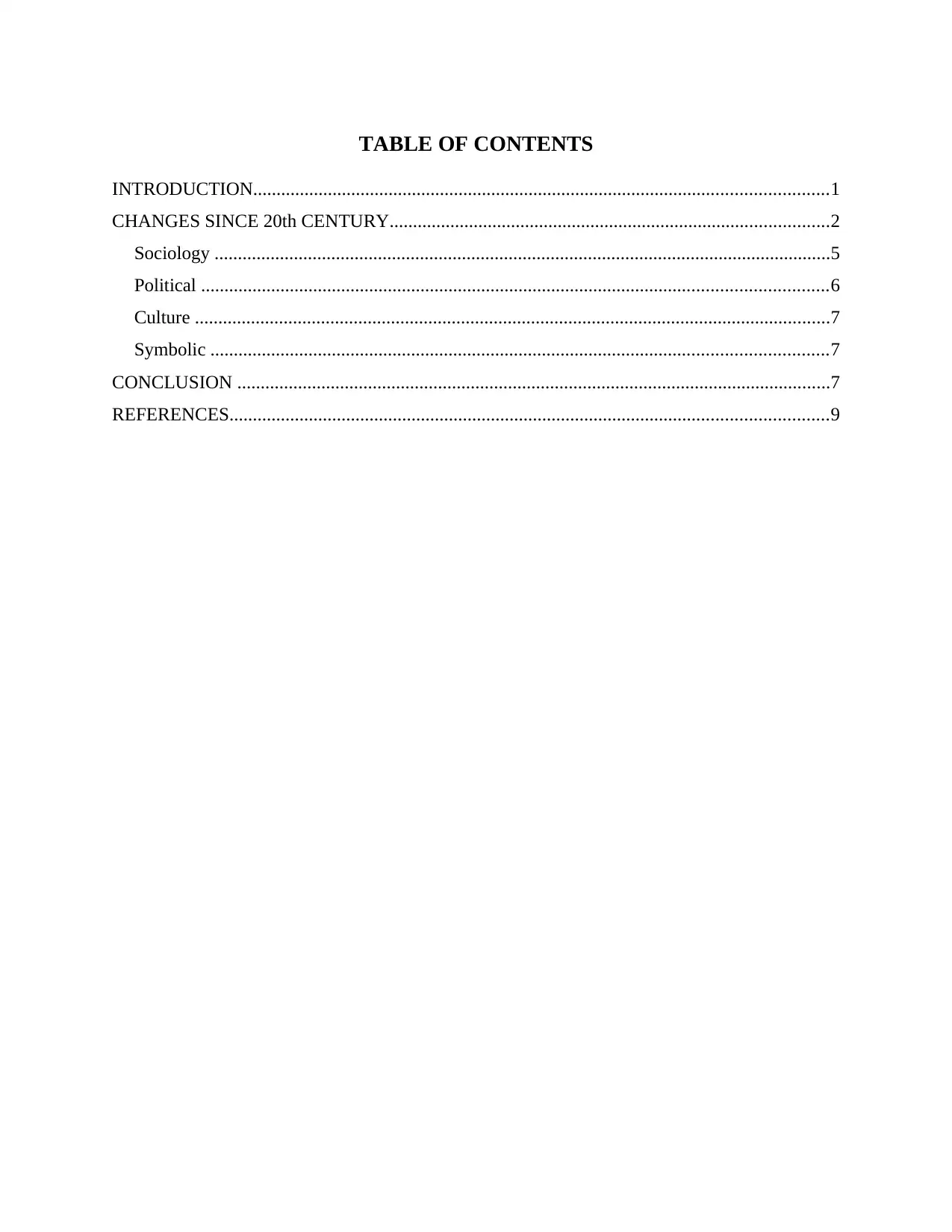
TABLE OF CONTENTS
INTRODUCTION...........................................................................................................................1
CHANGES SINCE 20th CENTURY..............................................................................................2
Sociology ....................................................................................................................................5
Political ......................................................................................................................................6
Culture ........................................................................................................................................7
Symbolic ....................................................................................................................................7
CONCLUSION ...............................................................................................................................7
REFERENCES................................................................................................................................9
INTRODUCTION...........................................................................................................................1
CHANGES SINCE 20th CENTURY..............................................................................................2
Sociology ....................................................................................................................................5
Political ......................................................................................................................................6
Culture ........................................................................................................................................7
Symbolic ....................................................................................................................................7
CONCLUSION ...............................................................................................................................7
REFERENCES................................................................................................................................9
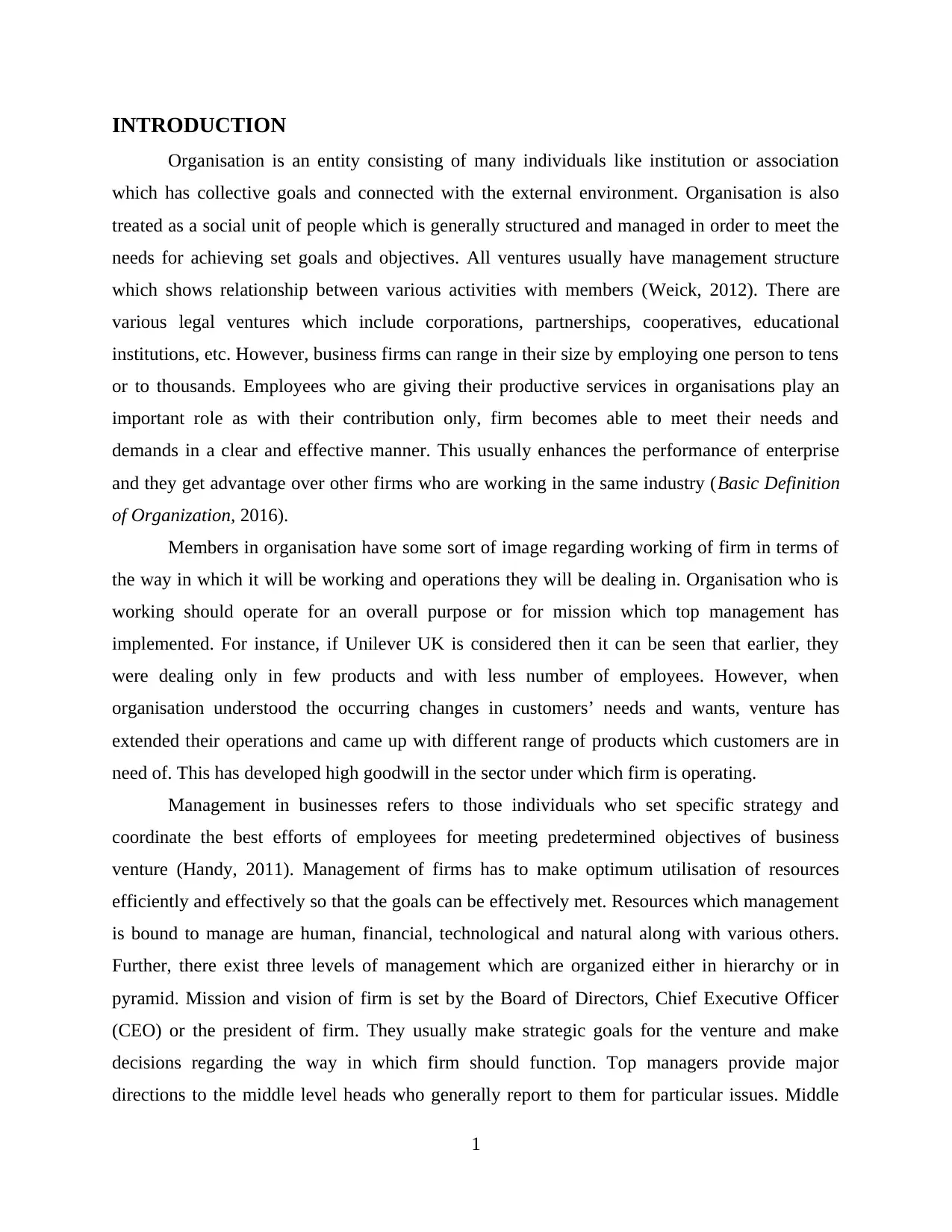
INTRODUCTION
Organisation is an entity consisting of many individuals like institution or association
which has collective goals and connected with the external environment. Organisation is also
treated as a social unit of people which is generally structured and managed in order to meet the
needs for achieving set goals and objectives. All ventures usually have management structure
which shows relationship between various activities with members (Weick, 2012). There are
various legal ventures which include corporations, partnerships, cooperatives, educational
institutions, etc. However, business firms can range in their size by employing one person to tens
or to thousands. Employees who are giving their productive services in organisations play an
important role as with their contribution only, firm becomes able to meet their needs and
demands in a clear and effective manner. This usually enhances the performance of enterprise
and they get advantage over other firms who are working in the same industry (Basic Definition
of Organization, 2016).
Members in organisation have some sort of image regarding working of firm in terms of
the way in which it will be working and operations they will be dealing in. Organisation who is
working should operate for an overall purpose or for mission which top management has
implemented. For instance, if Unilever UK is considered then it can be seen that earlier, they
were dealing only in few products and with less number of employees. However, when
organisation understood the occurring changes in customers’ needs and wants, venture has
extended their operations and came up with different range of products which customers are in
need of. This has developed high goodwill in the sector under which firm is operating.
Management in businesses refers to those individuals who set specific strategy and
coordinate the best efforts of employees for meeting predetermined objectives of business
venture (Handy, 2011). Management of firms has to make optimum utilisation of resources
efficiently and effectively so that the goals can be effectively met. Resources which management
is bound to manage are human, financial, technological and natural along with various others.
Further, there exist three levels of management which are organized either in hierarchy or in
pyramid. Mission and vision of firm is set by the Board of Directors, Chief Executive Officer
(CEO) or the president of firm. They usually make strategic goals for the venture and make
decisions regarding the way in which firm should function. Top managers provide major
directions to the middle level heads who generally report to them for particular issues. Middle
1
Organisation is an entity consisting of many individuals like institution or association
which has collective goals and connected with the external environment. Organisation is also
treated as a social unit of people which is generally structured and managed in order to meet the
needs for achieving set goals and objectives. All ventures usually have management structure
which shows relationship between various activities with members (Weick, 2012). There are
various legal ventures which include corporations, partnerships, cooperatives, educational
institutions, etc. However, business firms can range in their size by employing one person to tens
or to thousands. Employees who are giving their productive services in organisations play an
important role as with their contribution only, firm becomes able to meet their needs and
demands in a clear and effective manner. This usually enhances the performance of enterprise
and they get advantage over other firms who are working in the same industry (Basic Definition
of Organization, 2016).
Members in organisation have some sort of image regarding working of firm in terms of
the way in which it will be working and operations they will be dealing in. Organisation who is
working should operate for an overall purpose or for mission which top management has
implemented. For instance, if Unilever UK is considered then it can be seen that earlier, they
were dealing only in few products and with less number of employees. However, when
organisation understood the occurring changes in customers’ needs and wants, venture has
extended their operations and came up with different range of products which customers are in
need of. This has developed high goodwill in the sector under which firm is operating.
Management in businesses refers to those individuals who set specific strategy and
coordinate the best efforts of employees for meeting predetermined objectives of business
venture (Handy, 2011). Management of firms has to make optimum utilisation of resources
efficiently and effectively so that the goals can be effectively met. Resources which management
is bound to manage are human, financial, technological and natural along with various others.
Further, there exist three levels of management which are organized either in hierarchy or in
pyramid. Mission and vision of firm is set by the Board of Directors, Chief Executive Officer
(CEO) or the president of firm. They usually make strategic goals for the venture and make
decisions regarding the way in which firm should function. Top managers provide major
directions to the middle level heads who generally report to them for particular issues. Middle
1
⊘ This is a preview!⊘
Do you want full access?
Subscribe today to unlock all pages.

Trusted by 1+ million students worldwide
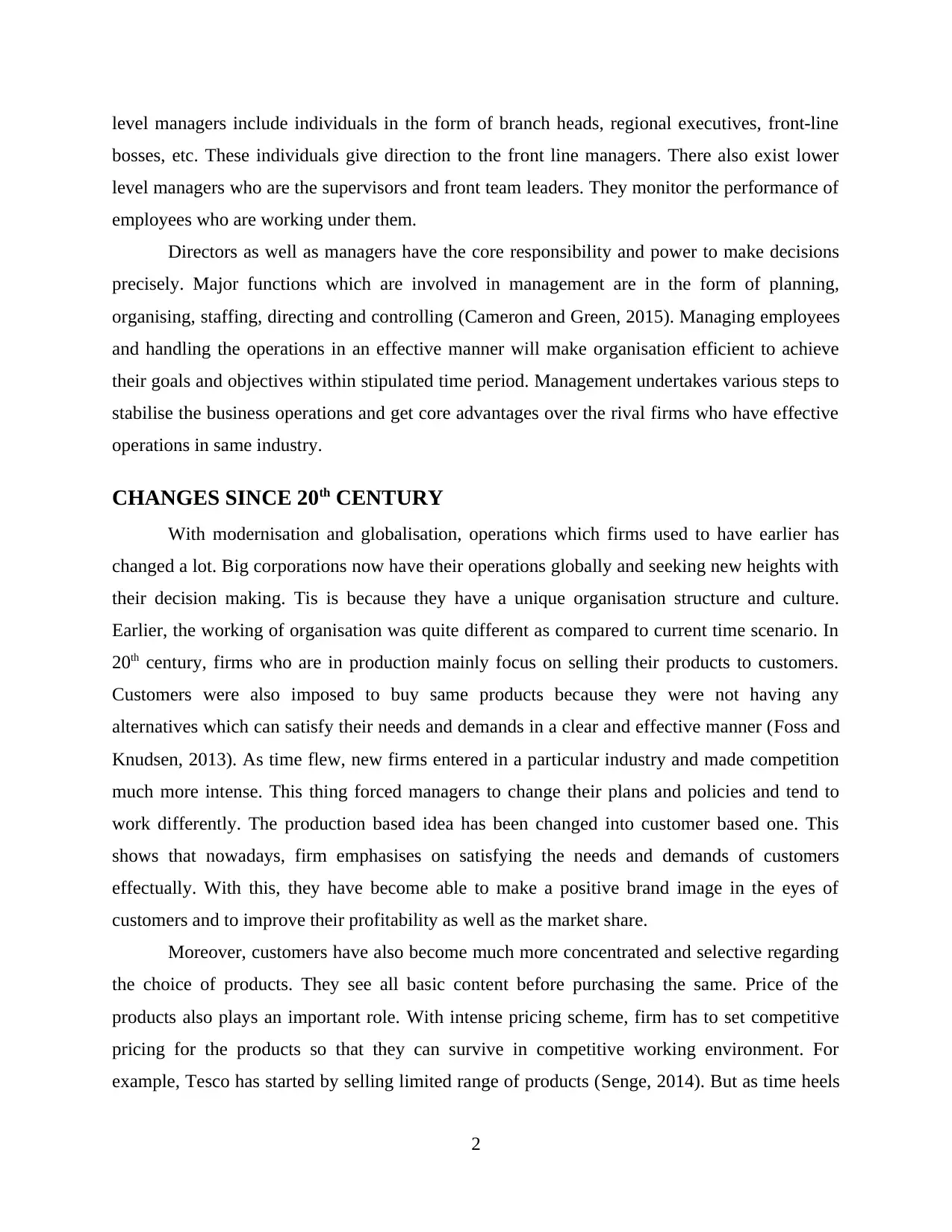
level managers include individuals in the form of branch heads, regional executives, front-line
bosses, etc. These individuals give direction to the front line managers. There also exist lower
level managers who are the supervisors and front team leaders. They monitor the performance of
employees who are working under them.
Directors as well as managers have the core responsibility and power to make decisions
precisely. Major functions which are involved in management are in the form of planning,
organising, staffing, directing and controlling (Cameron and Green, 2015). Managing employees
and handling the operations in an effective manner will make organisation efficient to achieve
their goals and objectives within stipulated time period. Management undertakes various steps to
stabilise the business operations and get core advantages over the rival firms who have effective
operations in same industry.
CHANGES SINCE 20th CENTURY
With modernisation and globalisation, operations which firms used to have earlier has
changed a lot. Big corporations now have their operations globally and seeking new heights with
their decision making. Tis is because they have a unique organisation structure and culture.
Earlier, the working of organisation was quite different as compared to current time scenario. In
20th century, firms who are in production mainly focus on selling their products to customers.
Customers were also imposed to buy same products because they were not having any
alternatives which can satisfy their needs and demands in a clear and effective manner (Foss and
Knudsen, 2013). As time flew, new firms entered in a particular industry and made competition
much more intense. This thing forced managers to change their plans and policies and tend to
work differently. The production based idea has been changed into customer based one. This
shows that nowadays, firm emphasises on satisfying the needs and demands of customers
effectually. With this, they have become able to make a positive brand image in the eyes of
customers and to improve their profitability as well as the market share.
Moreover, customers have also become much more concentrated and selective regarding
the choice of products. They see all basic content before purchasing the same. Price of the
products also plays an important role. With intense pricing scheme, firm has to set competitive
pricing for the products so that they can survive in competitive working environment. For
example, Tesco has started by selling limited range of products (Senge, 2014). But as time heels
2
bosses, etc. These individuals give direction to the front line managers. There also exist lower
level managers who are the supervisors and front team leaders. They monitor the performance of
employees who are working under them.
Directors as well as managers have the core responsibility and power to make decisions
precisely. Major functions which are involved in management are in the form of planning,
organising, staffing, directing and controlling (Cameron and Green, 2015). Managing employees
and handling the operations in an effective manner will make organisation efficient to achieve
their goals and objectives within stipulated time period. Management undertakes various steps to
stabilise the business operations and get core advantages over the rival firms who have effective
operations in same industry.
CHANGES SINCE 20th CENTURY
With modernisation and globalisation, operations which firms used to have earlier has
changed a lot. Big corporations now have their operations globally and seeking new heights with
their decision making. Tis is because they have a unique organisation structure and culture.
Earlier, the working of organisation was quite different as compared to current time scenario. In
20th century, firms who are in production mainly focus on selling their products to customers.
Customers were also imposed to buy same products because they were not having any
alternatives which can satisfy their needs and demands in a clear and effective manner (Foss and
Knudsen, 2013). As time flew, new firms entered in a particular industry and made competition
much more intense. This thing forced managers to change their plans and policies and tend to
work differently. The production based idea has been changed into customer based one. This
shows that nowadays, firm emphasises on satisfying the needs and demands of customers
effectually. With this, they have become able to make a positive brand image in the eyes of
customers and to improve their profitability as well as the market share.
Moreover, customers have also become much more concentrated and selective regarding
the choice of products. They see all basic content before purchasing the same. Price of the
products also plays an important role. With intense pricing scheme, firm has to set competitive
pricing for the products so that they can survive in competitive working environment. For
example, Tesco has started by selling limited range of products (Senge, 2014). But as time heels
2
Paraphrase This Document
Need a fresh take? Get an instant paraphrase of this document with our AI Paraphraser
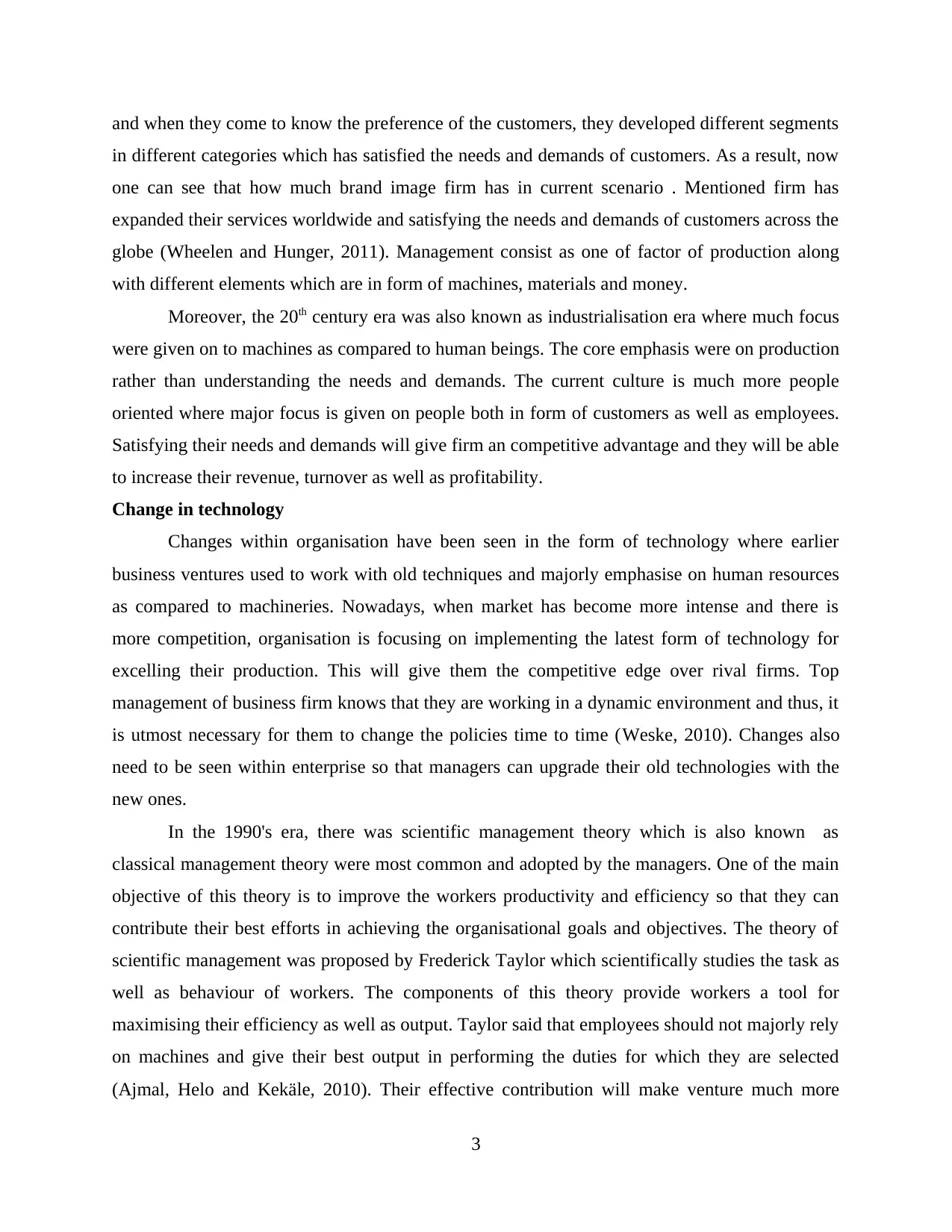
and when they come to know the preference of the customers, they developed different segments
in different categories which has satisfied the needs and demands of customers. As a result, now
one can see that how much brand image firm has in current scenario . Mentioned firm has
expanded their services worldwide and satisfying the needs and demands of customers across the
globe (Wheelen and Hunger, 2011). Management consist as one of factor of production along
with different elements which are in form of machines, materials and money.
Moreover, the 20th century era was also known as industrialisation era where much focus
were given on to machines as compared to human beings. The core emphasis were on production
rather than understanding the needs and demands. The current culture is much more people
oriented where major focus is given on people both in form of customers as well as employees.
Satisfying their needs and demands will give firm an competitive advantage and they will be able
to increase their revenue, turnover as well as profitability.
Change in technology
Changes within organisation have been seen in the form of technology where earlier
business ventures used to work with old techniques and majorly emphasise on human resources
as compared to machineries. Nowadays, when market has become more intense and there is
more competition, organisation is focusing on implementing the latest form of technology for
excelling their production. This will give them the competitive edge over rival firms. Top
management of business firm knows that they are working in a dynamic environment and thus, it
is utmost necessary for them to change the policies time to time (Weske, 2010). Changes also
need to be seen within enterprise so that managers can upgrade their old technologies with the
new ones.
In the 1990's era, there was scientific management theory which is also known as
classical management theory were most common and adopted by the managers. One of the main
objective of this theory is to improve the workers productivity and efficiency so that they can
contribute their best efforts in achieving the organisational goals and objectives. The theory of
scientific management was proposed by Frederick Taylor which scientifically studies the task as
well as behaviour of workers. The components of this theory provide workers a tool for
maximising their efficiency as well as output. Taylor said that employees should not majorly rely
on machines and give their best output in performing the duties for which they are selected
(Ajmal, Helo and Kekäle, 2010). Their effective contribution will make venture much more
3
in different categories which has satisfied the needs and demands of customers. As a result, now
one can see that how much brand image firm has in current scenario . Mentioned firm has
expanded their services worldwide and satisfying the needs and demands of customers across the
globe (Wheelen and Hunger, 2011). Management consist as one of factor of production along
with different elements which are in form of machines, materials and money.
Moreover, the 20th century era was also known as industrialisation era where much focus
were given on to machines as compared to human beings. The core emphasis were on production
rather than understanding the needs and demands. The current culture is much more people
oriented where major focus is given on people both in form of customers as well as employees.
Satisfying their needs and demands will give firm an competitive advantage and they will be able
to increase their revenue, turnover as well as profitability.
Change in technology
Changes within organisation have been seen in the form of technology where earlier
business ventures used to work with old techniques and majorly emphasise on human resources
as compared to machineries. Nowadays, when market has become more intense and there is
more competition, organisation is focusing on implementing the latest form of technology for
excelling their production. This will give them the competitive edge over rival firms. Top
management of business firm knows that they are working in a dynamic environment and thus, it
is utmost necessary for them to change the policies time to time (Weske, 2010). Changes also
need to be seen within enterprise so that managers can upgrade their old technologies with the
new ones.
In the 1990's era, there was scientific management theory which is also known as
classical management theory were most common and adopted by the managers. One of the main
objective of this theory is to improve the workers productivity and efficiency so that they can
contribute their best efforts in achieving the organisational goals and objectives. The theory of
scientific management was proposed by Frederick Taylor which scientifically studies the task as
well as behaviour of workers. The components of this theory provide workers a tool for
maximising their efficiency as well as output. Taylor said that employees should not majorly rely
on machines and give their best output in performing the duties for which they are selected
(Ajmal, Helo and Kekäle, 2010). Their effective contribution will make venture much more
3
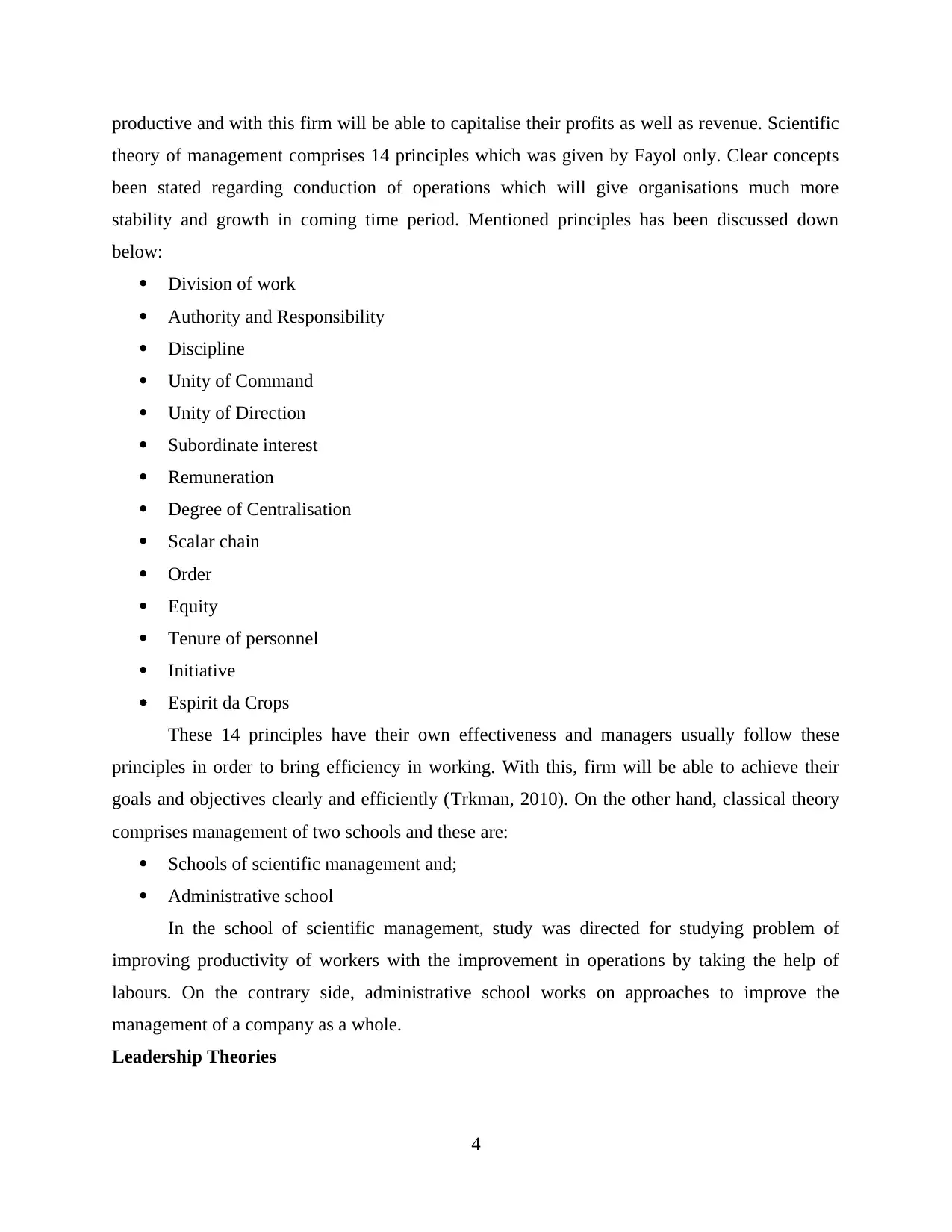
productive and with this firm will be able to capitalise their profits as well as revenue. Scientific
theory of management comprises 14 principles which was given by Fayol only. Clear concepts
been stated regarding conduction of operations which will give organisations much more
stability and growth in coming time period. Mentioned principles has been discussed down
below:
Division of work
Authority and Responsibility
Discipline
Unity of Command
Unity of Direction
Subordinate interest
Remuneration
Degree of Centralisation
Scalar chain
Order
Equity
Tenure of personnel
Initiative
Espirit da Crops
These 14 principles have their own effectiveness and managers usually follow these
principles in order to bring efficiency in working. With this, firm will be able to achieve their
goals and objectives clearly and efficiently (Trkman, 2010). On the other hand, classical theory
comprises management of two schools and these are:
Schools of scientific management and;
Administrative school
In the school of scientific management, study was directed for studying problem of
improving productivity of workers with the improvement in operations by taking the help of
labours. On the contrary side, administrative school works on approaches to improve the
management of a company as a whole.
Leadership Theories
4
theory of management comprises 14 principles which was given by Fayol only. Clear concepts
been stated regarding conduction of operations which will give organisations much more
stability and growth in coming time period. Mentioned principles has been discussed down
below:
Division of work
Authority and Responsibility
Discipline
Unity of Command
Unity of Direction
Subordinate interest
Remuneration
Degree of Centralisation
Scalar chain
Order
Equity
Tenure of personnel
Initiative
Espirit da Crops
These 14 principles have their own effectiveness and managers usually follow these
principles in order to bring efficiency in working. With this, firm will be able to achieve their
goals and objectives clearly and efficiently (Trkman, 2010). On the other hand, classical theory
comprises management of two schools and these are:
Schools of scientific management and;
Administrative school
In the school of scientific management, study was directed for studying problem of
improving productivity of workers with the improvement in operations by taking the help of
labours. On the contrary side, administrative school works on approaches to improve the
management of a company as a whole.
Leadership Theories
4
⊘ This is a preview!⊘
Do you want full access?
Subscribe today to unlock all pages.

Trusted by 1+ million students worldwide
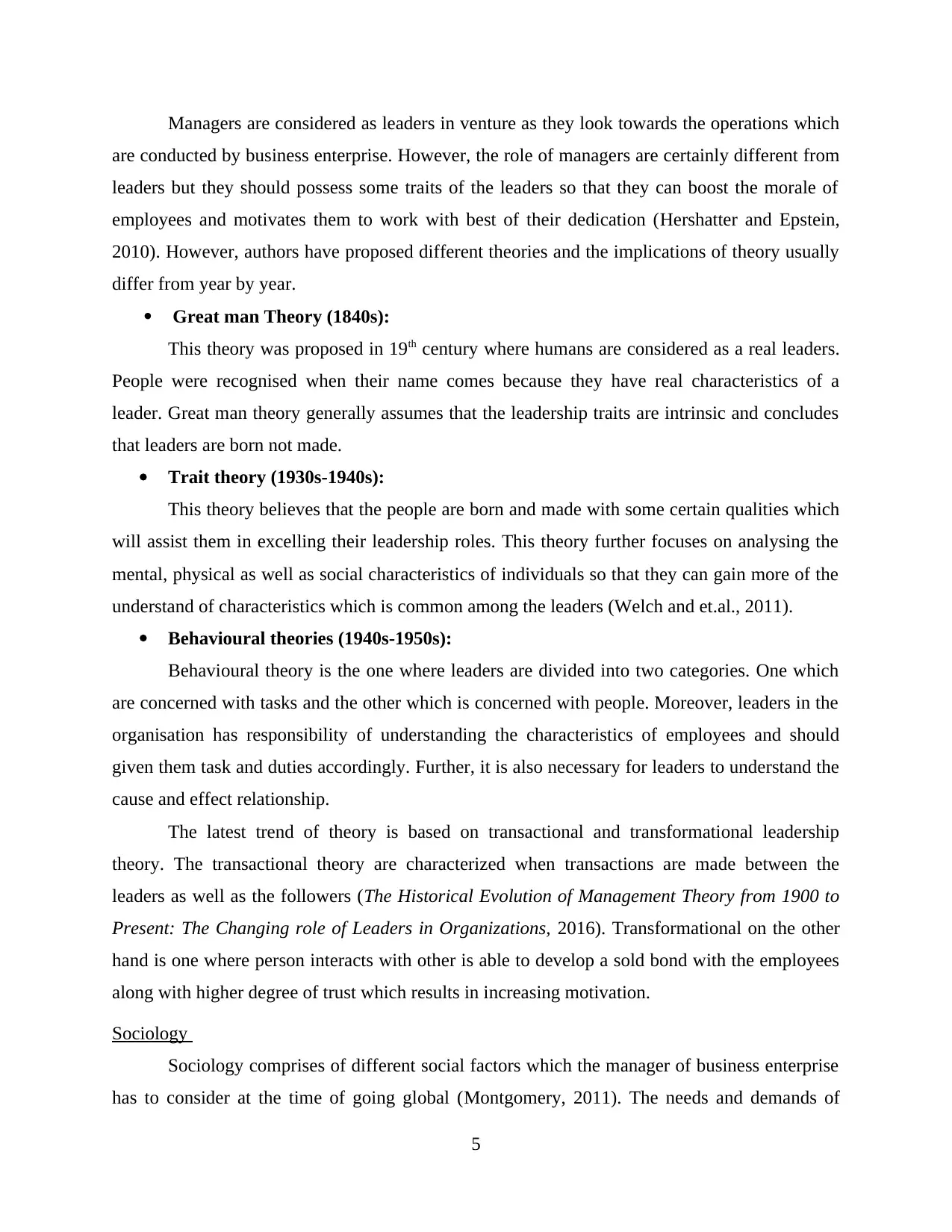
Managers are considered as leaders in venture as they look towards the operations which
are conducted by business enterprise. However, the role of managers are certainly different from
leaders but they should possess some traits of the leaders so that they can boost the morale of
employees and motivates them to work with best of their dedication (Hershatter and Epstein,
2010). However, authors have proposed different theories and the implications of theory usually
differ from year by year.
Great man Theory (1840s):
This theory was proposed in 19th century where humans are considered as a real leaders.
People were recognised when their name comes because they have real characteristics of a
leader. Great man theory generally assumes that the leadership traits are intrinsic and concludes
that leaders are born not made.
Trait theory (1930s-1940s):
This theory believes that the people are born and made with some certain qualities which
will assist them in excelling their leadership roles. This theory further focuses on analysing the
mental, physical as well as social characteristics of individuals so that they can gain more of the
understand of characteristics which is common among the leaders (Welch and et.al., 2011).
Behavioural theories (1940s-1950s):
Behavioural theory is the one where leaders are divided into two categories. One which
are concerned with tasks and the other which is concerned with people. Moreover, leaders in the
organisation has responsibility of understanding the characteristics of employees and should
given them task and duties accordingly. Further, it is also necessary for leaders to understand the
cause and effect relationship.
The latest trend of theory is based on transactional and transformational leadership
theory. The transactional theory are characterized when transactions are made between the
leaders as well as the followers (The Historical Evolution of Management Theory from 1900 to
Present: The Changing role of Leaders in Organizations, 2016). Transformational on the other
hand is one where person interacts with other is able to develop a sold bond with the employees
along with higher degree of trust which results in increasing motivation.
Sociology
Sociology comprises of different social factors which the manager of business enterprise
has to consider at the time of going global (Montgomery, 2011). The needs and demands of
5
are conducted by business enterprise. However, the role of managers are certainly different from
leaders but they should possess some traits of the leaders so that they can boost the morale of
employees and motivates them to work with best of their dedication (Hershatter and Epstein,
2010). However, authors have proposed different theories and the implications of theory usually
differ from year by year.
Great man Theory (1840s):
This theory was proposed in 19th century where humans are considered as a real leaders.
People were recognised when their name comes because they have real characteristics of a
leader. Great man theory generally assumes that the leadership traits are intrinsic and concludes
that leaders are born not made.
Trait theory (1930s-1940s):
This theory believes that the people are born and made with some certain qualities which
will assist them in excelling their leadership roles. This theory further focuses on analysing the
mental, physical as well as social characteristics of individuals so that they can gain more of the
understand of characteristics which is common among the leaders (Welch and et.al., 2011).
Behavioural theories (1940s-1950s):
Behavioural theory is the one where leaders are divided into two categories. One which
are concerned with tasks and the other which is concerned with people. Moreover, leaders in the
organisation has responsibility of understanding the characteristics of employees and should
given them task and duties accordingly. Further, it is also necessary for leaders to understand the
cause and effect relationship.
The latest trend of theory is based on transactional and transformational leadership
theory. The transactional theory are characterized when transactions are made between the
leaders as well as the followers (The Historical Evolution of Management Theory from 1900 to
Present: The Changing role of Leaders in Organizations, 2016). Transformational on the other
hand is one where person interacts with other is able to develop a sold bond with the employees
along with higher degree of trust which results in increasing motivation.
Sociology
Sociology comprises of different social factors which the manager of business enterprise
has to consider at the time of going global (Montgomery, 2011). The needs and demands of
5
Paraphrase This Document
Need a fresh take? Get an instant paraphrase of this document with our AI Paraphraser
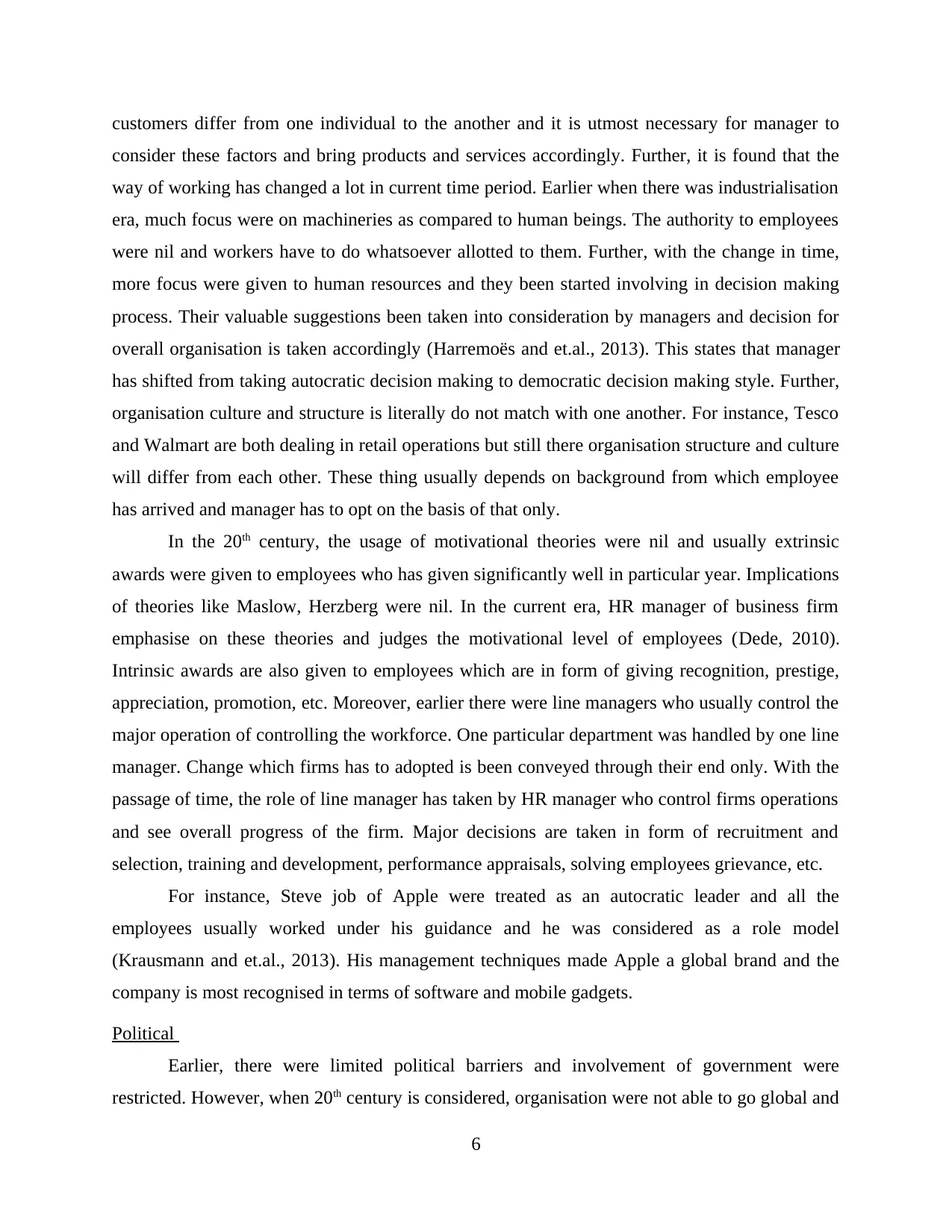
customers differ from one individual to the another and it is utmost necessary for manager to
consider these factors and bring products and services accordingly. Further, it is found that the
way of working has changed a lot in current time period. Earlier when there was industrialisation
era, much focus were on machineries as compared to human beings. The authority to employees
were nil and workers have to do whatsoever allotted to them. Further, with the change in time,
more focus were given to human resources and they been started involving in decision making
process. Their valuable suggestions been taken into consideration by managers and decision for
overall organisation is taken accordingly (Harremoës and et.al., 2013). This states that manager
has shifted from taking autocratic decision making to democratic decision making style. Further,
organisation culture and structure is literally do not match with one another. For instance, Tesco
and Walmart are both dealing in retail operations but still there organisation structure and culture
will differ from each other. These thing usually depends on background from which employee
has arrived and manager has to opt on the basis of that only.
In the 20th century, the usage of motivational theories were nil and usually extrinsic
awards were given to employees who has given significantly well in particular year. Implications
of theories like Maslow, Herzberg were nil. In the current era, HR manager of business firm
emphasise on these theories and judges the motivational level of employees (Dede, 2010).
Intrinsic awards are also given to employees which are in form of giving recognition, prestige,
appreciation, promotion, etc. Moreover, earlier there were line managers who usually control the
major operation of controlling the workforce. One particular department was handled by one line
manager. Change which firms has to adopted is been conveyed through their end only. With the
passage of time, the role of line manager has taken by HR manager who control firms operations
and see overall progress of the firm. Major decisions are taken in form of recruitment and
selection, training and development, performance appraisals, solving employees grievance, etc.
For instance, Steve job of Apple were treated as an autocratic leader and all the
employees usually worked under his guidance and he was considered as a role model
(Krausmann and et.al., 2013). His management techniques made Apple a global brand and the
company is most recognised in terms of software and mobile gadgets.
Political
Earlier, there were limited political barriers and involvement of government were
restricted. However, when 20th century is considered, organisation were not able to go global and
6
consider these factors and bring products and services accordingly. Further, it is found that the
way of working has changed a lot in current time period. Earlier when there was industrialisation
era, much focus were on machineries as compared to human beings. The authority to employees
were nil and workers have to do whatsoever allotted to them. Further, with the change in time,
more focus were given to human resources and they been started involving in decision making
process. Their valuable suggestions been taken into consideration by managers and decision for
overall organisation is taken accordingly (Harremoës and et.al., 2013). This states that manager
has shifted from taking autocratic decision making to democratic decision making style. Further,
organisation culture and structure is literally do not match with one another. For instance, Tesco
and Walmart are both dealing in retail operations but still there organisation structure and culture
will differ from each other. These thing usually depends on background from which employee
has arrived and manager has to opt on the basis of that only.
In the 20th century, the usage of motivational theories were nil and usually extrinsic
awards were given to employees who has given significantly well in particular year. Implications
of theories like Maslow, Herzberg were nil. In the current era, HR manager of business firm
emphasise on these theories and judges the motivational level of employees (Dede, 2010).
Intrinsic awards are also given to employees which are in form of giving recognition, prestige,
appreciation, promotion, etc. Moreover, earlier there were line managers who usually control the
major operation of controlling the workforce. One particular department was handled by one line
manager. Change which firms has to adopted is been conveyed through their end only. With the
passage of time, the role of line manager has taken by HR manager who control firms operations
and see overall progress of the firm. Major decisions are taken in form of recruitment and
selection, training and development, performance appraisals, solving employees grievance, etc.
For instance, Steve job of Apple were treated as an autocratic leader and all the
employees usually worked under his guidance and he was considered as a role model
(Krausmann and et.al., 2013). His management techniques made Apple a global brand and the
company is most recognised in terms of software and mobile gadgets.
Political
Earlier, there were limited political barriers and involvement of government were
restricted. However, when 20th century is considered, organisation were not able to go global and
6
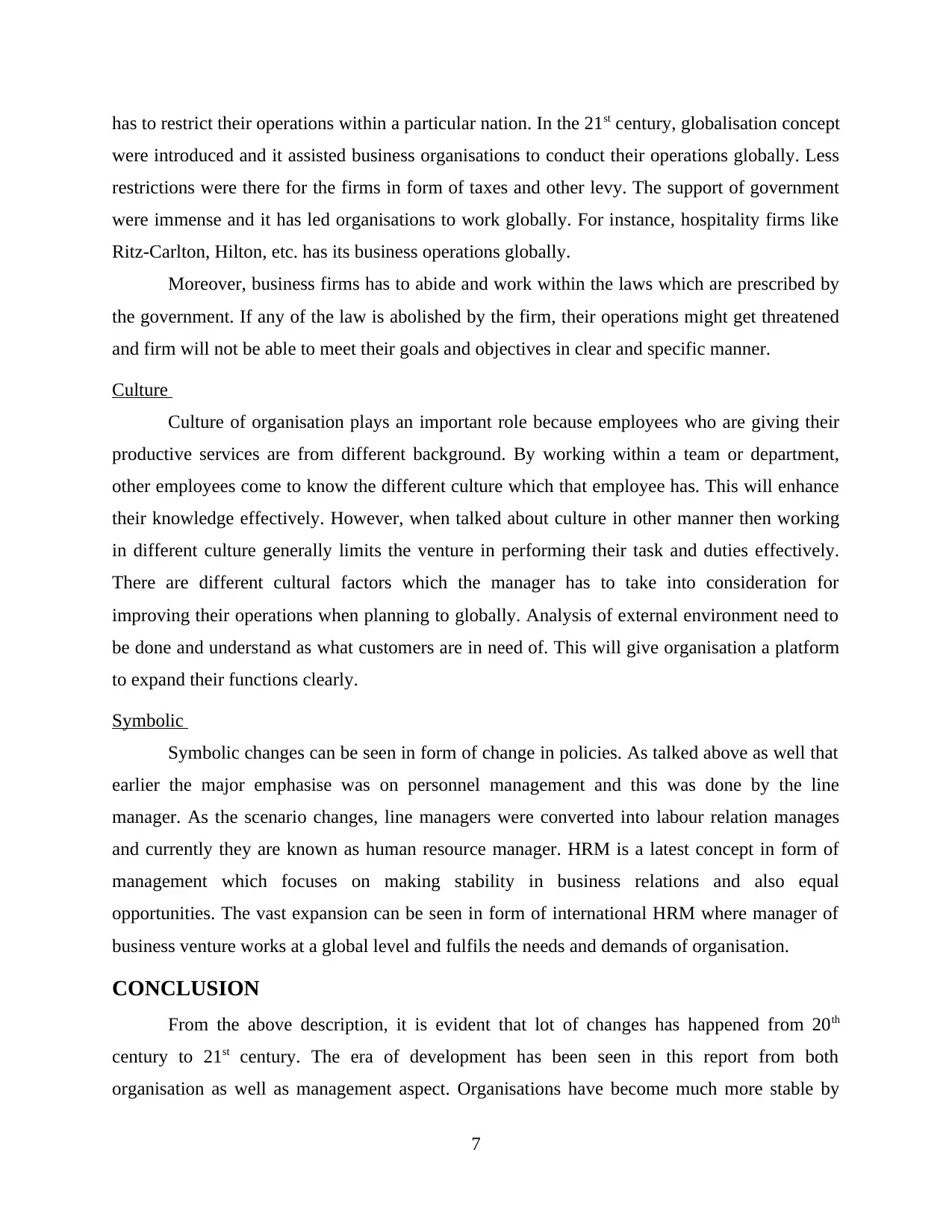
has to restrict their operations within a particular nation. In the 21st century, globalisation concept
were introduced and it assisted business organisations to conduct their operations globally. Less
restrictions were there for the firms in form of taxes and other levy. The support of government
were immense and it has led organisations to work globally. For instance, hospitality firms like
Ritz-Carlton, Hilton, etc. has its business operations globally.
Moreover, business firms has to abide and work within the laws which are prescribed by
the government. If any of the law is abolished by the firm, their operations might get threatened
and firm will not be able to meet their goals and objectives in clear and specific manner.
Culture
Culture of organisation plays an important role because employees who are giving their
productive services are from different background. By working within a team or department,
other employees come to know the different culture which that employee has. This will enhance
their knowledge effectively. However, when talked about culture in other manner then working
in different culture generally limits the venture in performing their task and duties effectively.
There are different cultural factors which the manager has to take into consideration for
improving their operations when planning to globally. Analysis of external environment need to
be done and understand as what customers are in need of. This will give organisation a platform
to expand their functions clearly.
Symbolic
Symbolic changes can be seen in form of change in policies. As talked above as well that
earlier the major emphasise was on personnel management and this was done by the line
manager. As the scenario changes, line managers were converted into labour relation manages
and currently they are known as human resource manager. HRM is a latest concept in form of
management which focuses on making stability in business relations and also equal
opportunities. The vast expansion can be seen in form of international HRM where manager of
business venture works at a global level and fulfils the needs and demands of organisation.
CONCLUSION
From the above description, it is evident that lot of changes has happened from 20th
century to 21st century. The era of development has been seen in this report from both
organisation as well as management aspect. Organisations have become much more stable by
7
were introduced and it assisted business organisations to conduct their operations globally. Less
restrictions were there for the firms in form of taxes and other levy. The support of government
were immense and it has led organisations to work globally. For instance, hospitality firms like
Ritz-Carlton, Hilton, etc. has its business operations globally.
Moreover, business firms has to abide and work within the laws which are prescribed by
the government. If any of the law is abolished by the firm, their operations might get threatened
and firm will not be able to meet their goals and objectives in clear and specific manner.
Culture
Culture of organisation plays an important role because employees who are giving their
productive services are from different background. By working within a team or department,
other employees come to know the different culture which that employee has. This will enhance
their knowledge effectively. However, when talked about culture in other manner then working
in different culture generally limits the venture in performing their task and duties effectively.
There are different cultural factors which the manager has to take into consideration for
improving their operations when planning to globally. Analysis of external environment need to
be done and understand as what customers are in need of. This will give organisation a platform
to expand their functions clearly.
Symbolic
Symbolic changes can be seen in form of change in policies. As talked above as well that
earlier the major emphasise was on personnel management and this was done by the line
manager. As the scenario changes, line managers were converted into labour relation manages
and currently they are known as human resource manager. HRM is a latest concept in form of
management which focuses on making stability in business relations and also equal
opportunities. The vast expansion can be seen in form of international HRM where manager of
business venture works at a global level and fulfils the needs and demands of organisation.
CONCLUSION
From the above description, it is evident that lot of changes has happened from 20th
century to 21st century. The era of development has been seen in this report from both
organisation as well as management aspect. Organisations have become much more stable by
7
⊘ This is a preview!⊘
Do you want full access?
Subscribe today to unlock all pages.

Trusted by 1+ million students worldwide
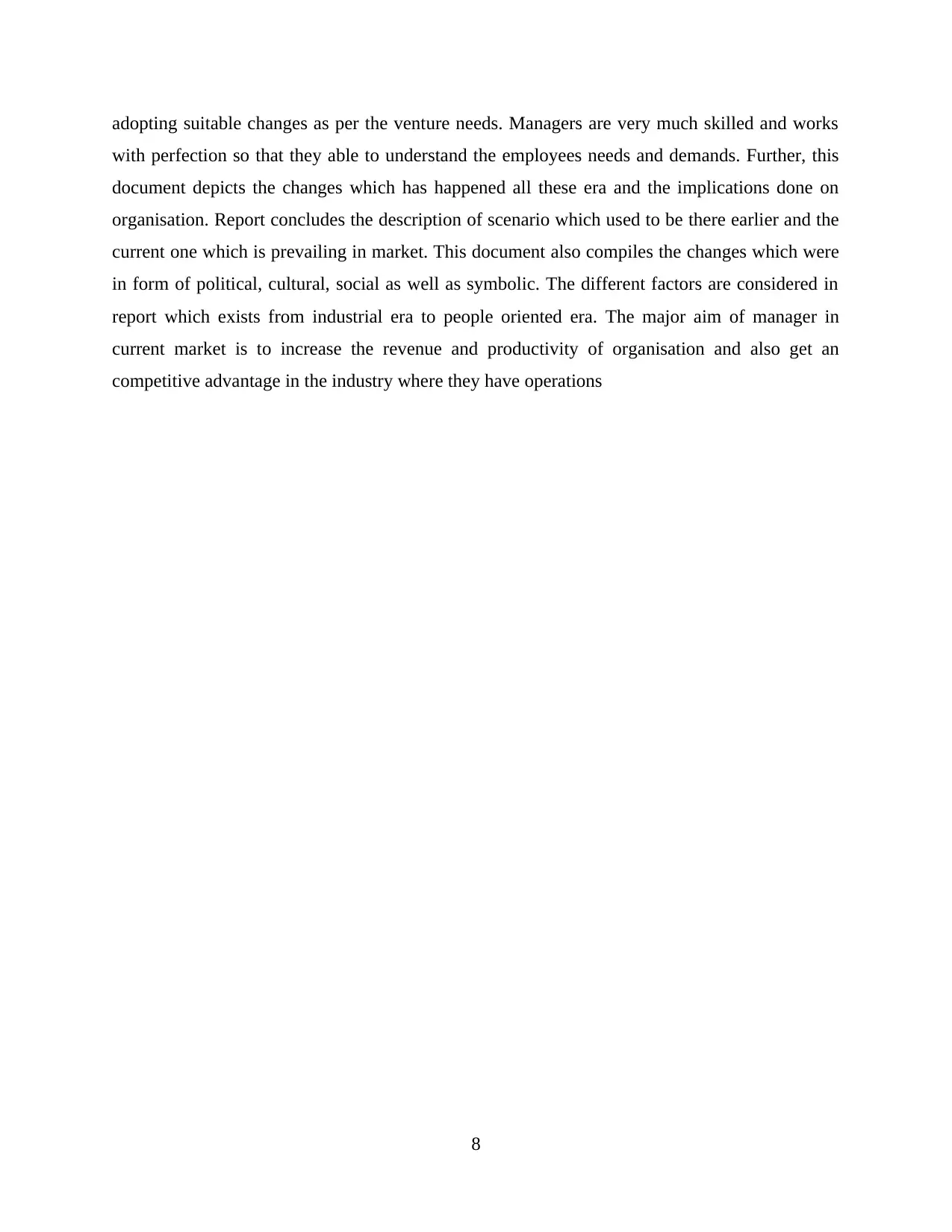
adopting suitable changes as per the venture needs. Managers are very much skilled and works
with perfection so that they able to understand the employees needs and demands. Further, this
document depicts the changes which has happened all these era and the implications done on
organisation. Report concludes the description of scenario which used to be there earlier and the
current one which is prevailing in market. This document also compiles the changes which were
in form of political, cultural, social as well as symbolic. The different factors are considered in
report which exists from industrial era to people oriented era. The major aim of manager in
current market is to increase the revenue and productivity of organisation and also get an
competitive advantage in the industry where they have operations
8
with perfection so that they able to understand the employees needs and demands. Further, this
document depicts the changes which has happened all these era and the implications done on
organisation. Report concludes the description of scenario which used to be there earlier and the
current one which is prevailing in market. This document also compiles the changes which were
in form of political, cultural, social as well as symbolic. The different factors are considered in
report which exists from industrial era to people oriented era. The major aim of manager in
current market is to increase the revenue and productivity of organisation and also get an
competitive advantage in the industry where they have operations
8
Paraphrase This Document
Need a fresh take? Get an instant paraphrase of this document with our AI Paraphraser
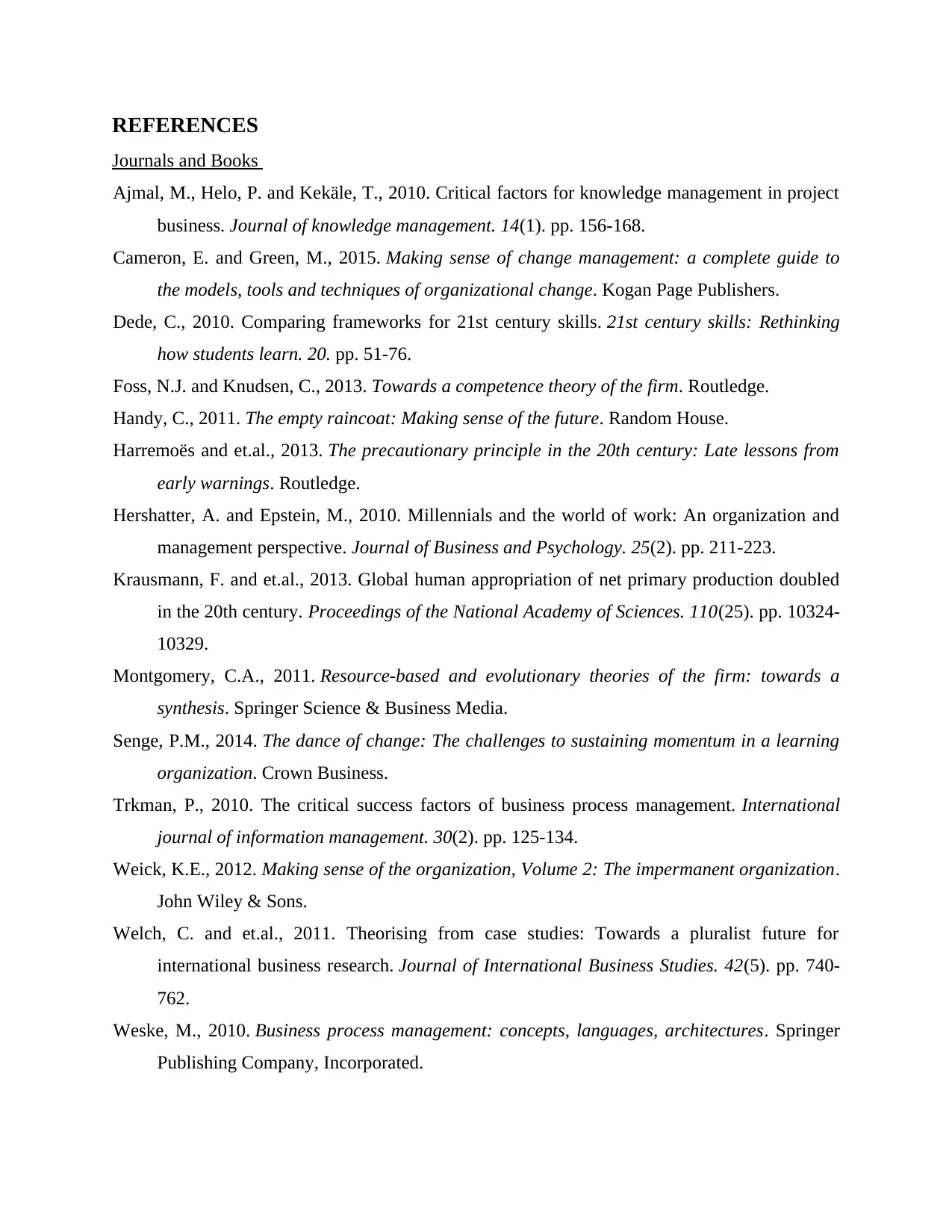
REFERENCES
Journals and Books
Ajmal, M., Helo, P. and Kekäle, T., 2010. Critical factors for knowledge management in project
business. Journal of knowledge management. 14(1). pp. 156-168.
Cameron, E. and Green, M., 2015. Making sense of change management: a complete guide to
the models, tools and techniques of organizational change. Kogan Page Publishers.
Dede, C., 2010. Comparing frameworks for 21st century skills. 21st century skills: Rethinking
how students learn. 20. pp. 51-76.
Foss, N.J. and Knudsen, C., 2013. Towards a competence theory of the firm. Routledge.
Handy, C., 2011. The empty raincoat: Making sense of the future. Random House.
Harremoës and et.al., 2013. The precautionary principle in the 20th century: Late lessons from
early warnings. Routledge.
Hershatter, A. and Epstein, M., 2010. Millennials and the world of work: An organization and
management perspective. Journal of Business and Psychology. 25(2). pp. 211-223.
Krausmann, F. and et.al., 2013. Global human appropriation of net primary production doubled
in the 20th century. Proceedings of the National Academy of Sciences. 110(25). pp. 10324-
10329.
Montgomery, C.A., 2011. Resource-based and evolutionary theories of the firm: towards a
synthesis. Springer Science & Business Media.
Senge, P.M., 2014. The dance of change: The challenges to sustaining momentum in a learning
organization. Crown Business.
Trkman, P., 2010. The critical success factors of business process management. International
journal of information management. 30(2). pp. 125-134.
Weick, K.E., 2012. Making sense of the organization, Volume 2: The impermanent organization.
John Wiley & Sons.
Welch, C. and et.al., 2011. Theorising from case studies: Towards a pluralist future for
international business research. Journal of International Business Studies. 42(5). pp. 740-
762.
Weske, M., 2010. Business process management: concepts, languages, architectures. Springer
Publishing Company, Incorporated.
Journals and Books
Ajmal, M., Helo, P. and Kekäle, T., 2010. Critical factors for knowledge management in project
business. Journal of knowledge management. 14(1). pp. 156-168.
Cameron, E. and Green, M., 2015. Making sense of change management: a complete guide to
the models, tools and techniques of organizational change. Kogan Page Publishers.
Dede, C., 2010. Comparing frameworks for 21st century skills. 21st century skills: Rethinking
how students learn. 20. pp. 51-76.
Foss, N.J. and Knudsen, C., 2013. Towards a competence theory of the firm. Routledge.
Handy, C., 2011. The empty raincoat: Making sense of the future. Random House.
Harremoës and et.al., 2013. The precautionary principle in the 20th century: Late lessons from
early warnings. Routledge.
Hershatter, A. and Epstein, M., 2010. Millennials and the world of work: An organization and
management perspective. Journal of Business and Psychology. 25(2). pp. 211-223.
Krausmann, F. and et.al., 2013. Global human appropriation of net primary production doubled
in the 20th century. Proceedings of the National Academy of Sciences. 110(25). pp. 10324-
10329.
Montgomery, C.A., 2011. Resource-based and evolutionary theories of the firm: towards a
synthesis. Springer Science & Business Media.
Senge, P.M., 2014. The dance of change: The challenges to sustaining momentum in a learning
organization. Crown Business.
Trkman, P., 2010. The critical success factors of business process management. International
journal of information management. 30(2). pp. 125-134.
Weick, K.E., 2012. Making sense of the organization, Volume 2: The impermanent organization.
John Wiley & Sons.
Welch, C. and et.al., 2011. Theorising from case studies: Towards a pluralist future for
international business research. Journal of International Business Studies. 42(5). pp. 740-
762.
Weske, M., 2010. Business process management: concepts, languages, architectures. Springer
Publishing Company, Incorporated.
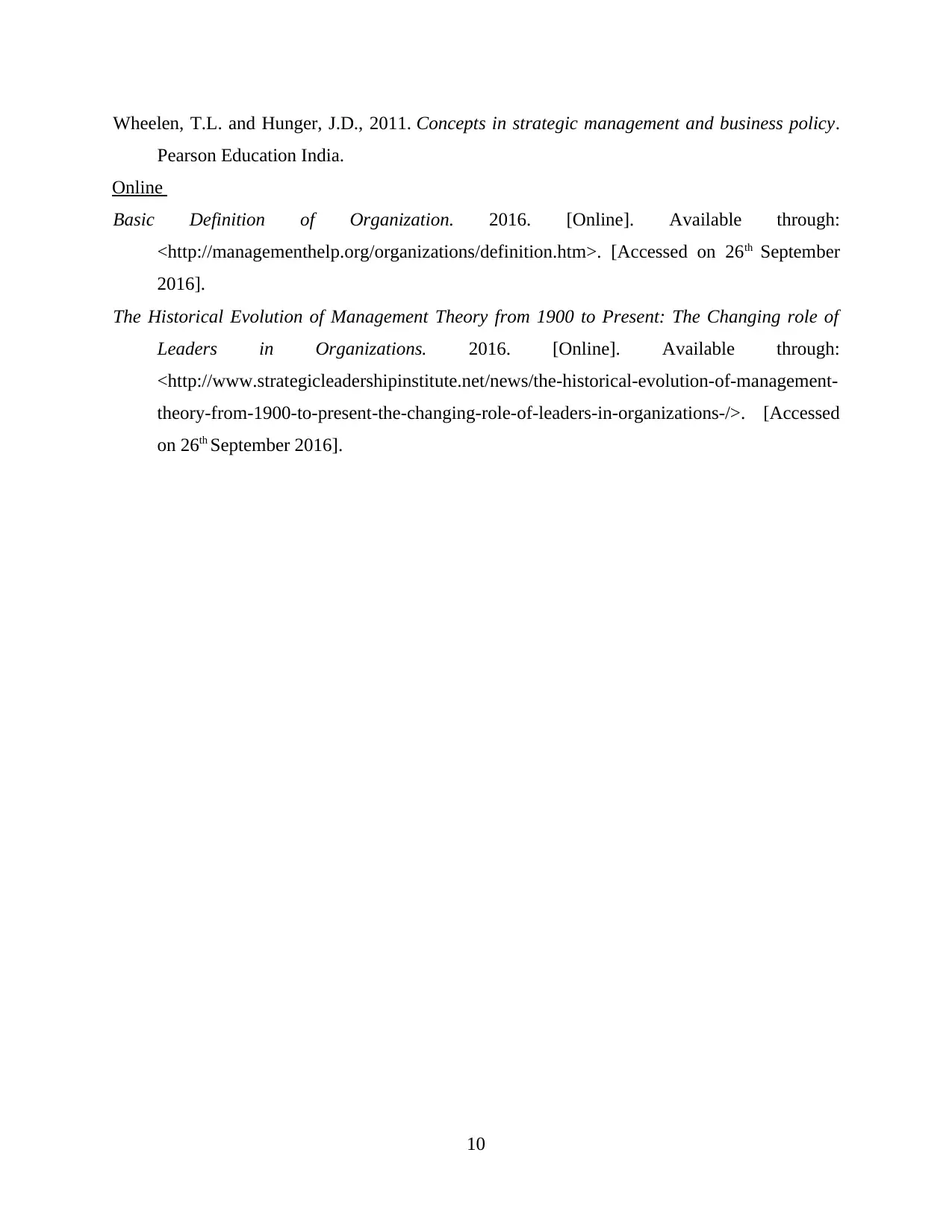
Wheelen, T.L. and Hunger, J.D., 2011. Concepts in strategic management and business policy.
Pearson Education India.
Online
Basic Definition of Organization. 2016. [Online]. Available through:
<http://managementhelp.org/organizations/definition.htm>. [Accessed on 26th September
2016].
The Historical Evolution of Management Theory from 1900 to Present: The Changing role of
Leaders in Organizations. 2016. [Online]. Available through:
<http://www.strategicleadershipinstitute.net/news/the-historical-evolution-of-management-
theory-from-1900-to-present-the-changing-role-of-leaders-in-organizations-/>. [Accessed
on 26th September 2016].
10
Pearson Education India.
Online
Basic Definition of Organization. 2016. [Online]. Available through:
<http://managementhelp.org/organizations/definition.htm>. [Accessed on 26th September
2016].
The Historical Evolution of Management Theory from 1900 to Present: The Changing role of
Leaders in Organizations. 2016. [Online]. Available through:
<http://www.strategicleadershipinstitute.net/news/the-historical-evolution-of-management-
theory-from-1900-to-present-the-changing-role-of-leaders-in-organizations-/>. [Accessed
on 26th September 2016].
10
⊘ This is a preview!⊘
Do you want full access?
Subscribe today to unlock all pages.

Trusted by 1+ million students worldwide
1 out of 12
Related Documents
Your All-in-One AI-Powered Toolkit for Academic Success.
+13062052269
info@desklib.com
Available 24*7 on WhatsApp / Email
![[object Object]](/_next/static/media/star-bottom.7253800d.svg)
Unlock your academic potential
Copyright © 2020–2025 A2Z Services. All Rights Reserved. Developed and managed by ZUCOL.





